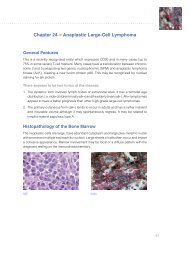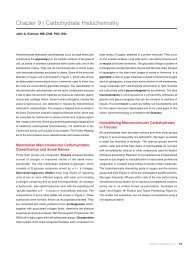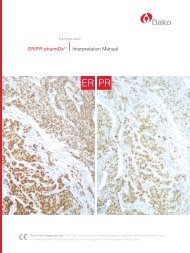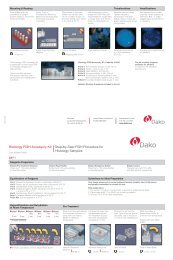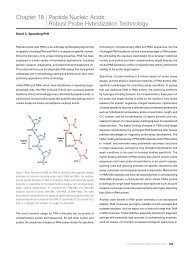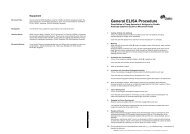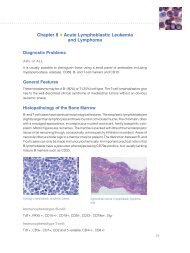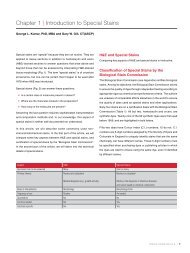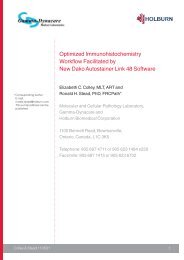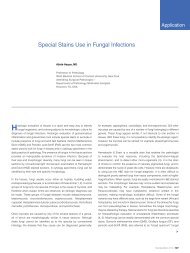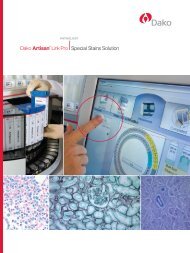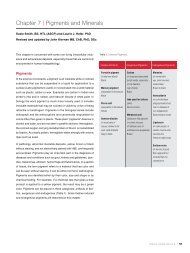Chapter 15 | Multi-Staining Immunohistochemistry - Dako
Chapter 15 | Multi-Staining Immunohistochemistry - Dako
Chapter 15 | Multi-Staining Immunohistochemistry - Dako
You also want an ePaper? Increase the reach of your titles
YUMPU automatically turns print PDFs into web optimized ePapers that Google loves.
<strong>Multi</strong>-<strong>Staining</strong> <strong>Immunohistochemistry</strong><br />
one solution is the dako animal Research Kit (aRK ), which contains<br />
reagents for labeling mouse primary antibodies with a biotinylated<br />
anti-mouse Fab fragment, followed by blocking of the remaining<br />
reagent with normal mouse serum. this can be applied to the tissue<br />
as part of the multi-step technique (5). the kit gives a non-covalently<br />
labeled antibody, thus avoiding the risk of reducing the affinity. In<br />
addition, only small amounts of primary antibody are needed and the<br />
kit does not require time-consuming purification steps.<br />
another solution is Zenon technology (Invitrogen) developed for flow<br />
cytometry. It essentially uses the same technique and offers labeling<br />
kits for mouse primary antibodies available as enzyme conjugates or<br />
conjugated to one of a wide variety of fluorescent dyes.<br />
Finally, it is important to be aware of the fact that visualization systems<br />
with dual recognition such as the enVision + dual Link System do not<br />
discriminate between species, and thus are only suitable for multiple<br />
staining when using the sequential method. Visualization kits with<br />
amplification layers that are not well specified should be avoided since<br />
possible cross-reactivity cannot be predicted.<br />
Selection of Dyes<br />
the primary choice to make when deciding how to make the targets<br />
visible is whether to use immunoenzyme staining or fluorescence.<br />
Both have advantages and disadvantages and in the end, decisions<br />
should be made based on conditions of the individual experiment.<br />
Chromogenic Dyes<br />
examples of enzyme/chromogen pairs suitable for triple staining are:<br />
gal/X-gal/turquoise, aP/Fast blue, HRP/aeC/Red<br />
HRP/daP/Brown, gal/X-gal/turquoise, aP/Fast red<br />
HRP/daP/Brown, aP/new Fucsin/Red, HRP/tMB/green<br />
When selecting color combinations for multiple staining with<br />
chromogenic dyes, it is advisable to choose opposing colors in<br />
the color spectrum such as red and green to facilitate spectral<br />
differentiation. If using a counterstain, this must also be included<br />
in the considerations. When working with co-localized targets,<br />
dyes must be chosen so that it is possible to distinguish the mixed<br />
color from the individual colors. double staining using chromogenic<br />
106 | IHC StaInIng MetHodS, FIFtH edItIon<br />
dyes is well-established, but if the targets are co-localized, the<br />
percentage of the single colors cannot be easily identified (6). For a<br />
triple staining, it is naturally more difficult to choose colors that can<br />
be unambiguously differentiated and even more so, if targets are<br />
co-localized. In such cases, a technique known as spectral imaging<br />
may be applied (2). Spectral imaging allows images of the single<br />
stains to be scanned and by using specialized software algorithms<br />
the colors are unmixed displaying the distribution and abundance of<br />
the individual chromogens.<br />
Visualizing Rare Targets<br />
a narrow, dynamic range is a disadvantage for immunoenzymatic<br />
staining. the precipitation process, which is crucial for this method,<br />
is only triggered at a certain concentration of substrate and product.<br />
on the other hand, at high concentrations the precipitated product<br />
may inhibit further reaction. therefore, it is difficult to visualize rare<br />
targets and highly abundant targets in the same slide. to ease this<br />
problem, catalyzed signal amplification — an extremely sensitive<br />
IHC staining procedure (such as e.g. CSa from dako) can be used.<br />
the method can bring rare targets within the same dynamic range<br />
as highly expressed targets.<br />
Fluorescent Dyes<br />
double immunofluorescence labeling is quite well established (7). Some<br />
of the same considerations as with chromogenic dyes apply when<br />
working with immunofluorescence. It is equally necessary to select<br />
dyes with distinguishable spectral properties. However, there are more<br />
colors available and the emissions spectra of the fluorescent molecules<br />
are narrower than the spectra of the chromogenic dyes. the use of<br />
multiple-fluorescent colors is also well established in FISH and flow<br />
cytometry, where dichroic and excitation/emission filters are employed<br />
to separate different fluorescent signals. the spectral separation can<br />
be aided by digital compensation for overlapping emission spectra.<br />
In addition, new fluorescent microscope systems such as e.g. Laser<br />
Scanning Confocal Microscope can unmix the spectral signatures of<br />
up to eight fluorochromes without any problems using multi-spectral<br />
imaging techniques such as e.g. emission fingerprinting (8).



